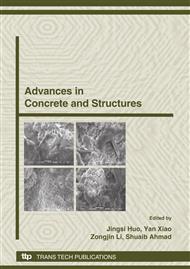p.743
p.749
p.757
p.763
p.769
p.775
p.783
p.789
p.795
Effects of Sustained Pre-Load on Residual Strength and Stiffness of Concrete-Filled Steel Tube after Exposure to High Temperatures
Abstract:
This paper experimentally investigated the effects of axial load level on the residual strength and stiffness of concrete-filled steel tubular (CFT) stub columns which were heated and cooled down to room temperature under sustained axial load. Eight stub columns were axially loaded and heated to specified high temperatures in a purpose-built electric furnace. After the specimens cooled down to room temperature while the axial load was kept constant, the stub columns were loaded to failure. The test results show that not only the axial load level and the high temperature exposure have significant effects on the residual strength and stiffness of stub column, but the residual strength index and stiffness index of the fire-damaged CFT stub columns with pre-load are remarkably different from those without pre-load. From the test results, it is recommended that the sustained axial load effects and the fire cooling phase should be taken into consideration in assessing the fire-damaged CFT columns.
Info:
Periodical:
Pages:
769-774
Citation:
Online since:
October 2008
Authors:
Price:
Сopyright:
© 2009 Trans Tech Publications Ltd. All Rights Reserved
Share:
Citation:


